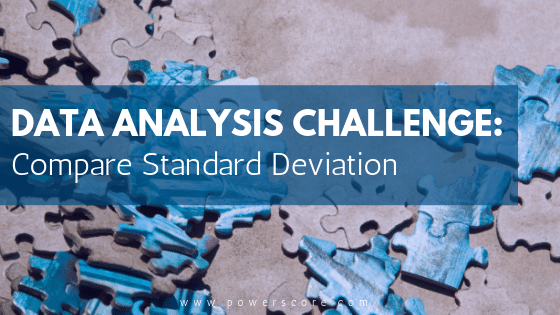GRE data analysis includes some tough Quant topics. One is standard deviation, a measure of how far the values in a data set tend to fall from the set’s mean. This statistic can be confusing and tedious to calculate. Luckily, you probably won’t need to calculate it when it comes up on the exam. Try this hard standard deviation question to see what I mean.
Question Difficulty Level: 4 (High)
Data Analysis: Frequency Distributions, Standard Deviation
The Challenge
In The Practice Book for the Paper-based GRE, a hard Data Analysis question shows you two histograms—bar graphs of frequency distributions—and asks you to compare their standard deviations. (See §5, 8.) When the question was on a real exam, not a lot of text takers got it—just 27%. Here’s a similarly difficult problem.
The frequency distributions shown above represent two groups of data. Each of the data values is a multiple of 10.
- Quantity A
- The standard deviation of distribution A
- Quantity B
- The standard deviation of distribution B
- Quantity A is greater.
- Quantity B is greater.
- The two quantities are equal.
- The relationship cannot be determined from the information given.
The Solution
Compare the two groups of data. What’s the same? They include the same values—10, 20, 30, 40, 50—and the same frequency of the value 30.
Now contrast the two groups. You see their distributions are flipped. Distribution A skews left toward the lower values, whereas distribution B skews right toward the higher ones. Consequently, the averages differ. Group A’s average is lower than Group B’s.
Do their standard deviations differ? You might think so. After all, the standard deviation depends on the mean, and the two groups have different means. But think again. The standard deviation doesn’t grow or shrink simply because the average does. If the spread of the data remains the same then the standard deviation does, too.
Distributions A and B have the same spread and thus the same standard deviation. Again, the direction or skew of each distribution differs, with A pulling left and B pulling right, but this difference affects the size of the mean, not the distance that values tend to fall from it.
Think of distributions A and B as equal but opposite changes to the symmetrical distribution N. Distribution A boosts the frequency of the lowest and next to lowest values in N, whereas distribution B boosts the frequency of the highest and next to highest values in N. As a result, distributions A and B pull the average of N in opposite directions but make equal adjustments to its standard deviation.
Thus, the standard deviations of distributions A and B are equal. The correct answer is (C).
Ready for more? Check out some of the Hardest and Most Tested Math Topics on the GRE.





Leave a Reply
You must be logged in to post a comment.